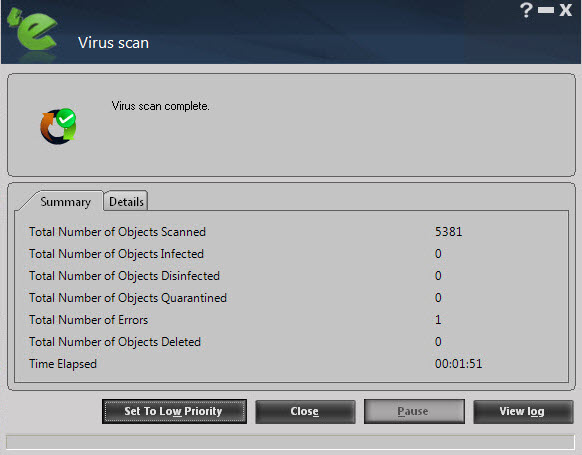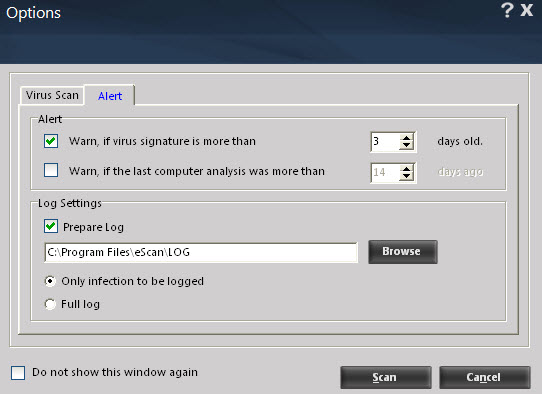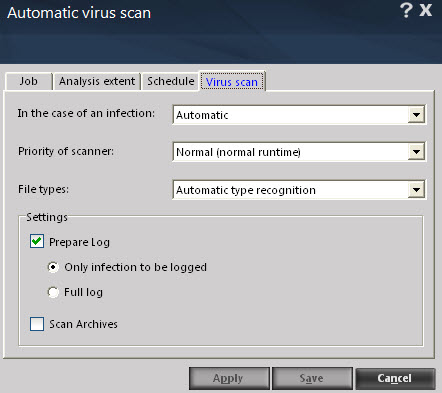From eScan Wiki
Contents |
Scan
The Scan option helps you perform on demand scans on files, folders, storage devices, and the registry and schedule automatic scans. It checks your computer for security threats, such as viruses, spyware, and other malicious software and creates logs of all scan operations.
When you click the Scan button on the eScan for AV, the Scan tabbed page is displayed. This page provides you with options for scanning the computer and storage devices, configuring the Scan option, and scheduling scans. The Virus scan dialog box contains options for scanning the memory, drives, peripheral storage devices, registry, and services running on the computer for viruses and other malware. It displays information about the total number of objects that have been scanned, infected, disinfected, quarantined, total number of errors, deleted, and time elapsed since the beginning of the scan. In addition, it provides you with an option to run scan in low-priority process by clicking the Set To Low Priority button. After you have finished scanning the computer, you can view the log files by clicking the View log button.
You can click the Custom Scan Options dialog box to perform customized scans by configuring eScan to scan the selected storage devices or objects for malicious software. This dialog box provides you with several scan options, such as Scan CD-ROM, Scan USB Drives, Scan Spyware and Adware, Scan Startup, and Scan memory, registry and services check boxes and Scan local hard drives and Scan following directories and files options to scan specific files and folders for malware. In addition, on the Scan screen you have the following buttons:
Options
You can configure Scan options by clicking the Options button. This will display the Options dialog box, which provides you with options for configuring the Scan option. This dialog box has two panes: Virus Scan and Alert.
Note: After configuring all the required settings, click the Save button.
- Virus Scan
This tab helps you configure the actions that eScan should perform when an infection is detected. It allows you to set priority of the scan process as High, Normal, or Low. It also helps you configure eScan to automatically recognize either all file types or only program files.
- In the case of an infection: This list helps you configure the action that eScan should perform on the file when it finds that it is infected. The actions are as follows:
- Log only: When you select this option, eScan only logs the occurrence of the virus infection without taking any action.
- Delete infected file: When you select this option, eScan deletes the infected file.
- Automatic: [Default] When you select this option, eScan first tries to clean the file. If it is not possible to disinfect the file, eScan quarantines or deletes the file.
- Priority of scanner: This option helps you set the priority of the eScan scanner in relation to other processes running on the computer. The priority level can be high, normal, or low. By default, the scanner runs with low priority.
- File types: This option helps you select the type of files that should be scanned by On-demand Scan.
- Automatic type recognition: [Default] When you select this option, On-demand Scan will scan all files, but will ignore files that cannot be infected.
- Only program files: When you select this option, On-demand Scan will scan only the program files or executables stored on your computer.
- Use separate exclude list for ODS: [Default] Select this check box, if you want eScan to exclude all the listed files, folders, and sub folders from monitoring during the on-demand scan. This option helps eScan to separate the exclude list of on-demand scanning from real-time scanning exclude list.
- Add/Delete: Click this button, if you want to add or delete the files, folders, and sub folders. On the Exclude Folders dialog box, click the Add button and click an appropriate object type, and then type or click Browse button to select the file or folder that you want to exclude. If you want to include sub folder of a folder, select Sub folder check box.
- In the case of an infection: This list helps you configure the action that eScan should perform on the file when it finds that it is infected. The actions are as follows:
- To delete any file/folder, click an appropriate file/folder from the list, and then click the Delete button. To remove all the files/folders from the list, click the Remove All button.
- Scan Archives: Select this check box, if you want eScan to scan both archived and packed files.
- Alert
This tab helps you configure eScan to alert you when it detects malicious software on your computer.
- Alert: In this section, you can configure when eScan should notify you when the virus definitions are outdated or when a specified number of days have elapsed since you have last scanned your computer.
- Warn, if virus signature is more than: [Default] When you select this check box, eScan will notify you if the virus signature is older than the specified number of days. By default, eScan notifies you when your virus definitions are more than 3 days old.
- Warn, if the last computer analysis was more than: When you select this check box, eScan will notify you when a specified number of days have elapsed since the computer was last analysed. By default, the value is 14.
- Alert: In this section, you can configure when eScan should notify you when the virus definitions are outdated or when a specified number of days have elapsed since you have last scanned your computer.
- Log Settings: In this section, you can configure the log settings for the Scan option.
- Prepare log: [Default] When you select this check box, eScan creates an On-demand Scan log file at the specified path. The default path is c:\Program Files\eScan\LOG.
- Only infection to be logged: [Default] When this option is selected, eScan will log information only about infected files and the action taken on them in the On-demand Scan log.
- Full log: When this option is selected, the On-demand Scan log will contain information about all the files scanned by eScan.
- Log Settings: In this section, you can configure the log settings for the Scan option.
Scheduler
In this section, you can schedule On-demand Scan to scan your computer and storage devices for malicious objects. It contains a table, which displays name of the schedule, frequency of occurrence, and the next time it will be run. This dialog box includes an Add task button, which helps you add a new scan task to the schedule.
- Add task: When you click this button, eScan opens the Automatic virus scan dialog box. This dialog box includes the Job, Analysis extent, Schedule, and Virus scan tabs.
- Note: After configuring all the required settings on the Automatic virus scan dialog box, click the Apply button and then Save button to save the settings and click the Cancel button to cancel the configured settings or to close the dialog box.
- Job: This tab helps you specify the name, start type, and termination condition for a new task. If you select the start type as Start in foreground, task will run in the foreground, otherwise, task will run in the background and its window will be minimized. You can also select the termination condition for the task. For example, you can specify that the On-demand Scan should always quit automatically after it has finished scanning.
- Analysis extent: This tab presents you with options that help you select the type of scanning, and the list of directories, folders, or local hard drives to be scanned.
- Schedule: This tab helps you configure the options for scheduling system scans. You can schedule scans to run either once or on a daily, hourly, weekly, monthly basis, when the computer boots up, or on a given date at a specific time.
- Virus scan: This tab provides you with the same options as the ones present on the Virus scan tab of the Scan option. You can configure On-demand Scan to perform a specific action when a virus infection is detected. You can also set the priority of the eScan scanner in relation to other processes running on the computer. The priority level can be high, normal, or low. By default, the scanner runs with low priority. In addition, you can configure On-demand Scan to scan only program files or executable files.
Logs
You can view reports of the scheduled On-demand scans performed on your computer and storage devices in the Logs dialog box.











